In this set of three analyses, I am giving a brief tactical analysis of all 18 teams in the Bundesliga.
I teamed up with Zoltan Toth, an excellent data analyst who also writes for the site, and he created these fantastic graphs to highlight every team’s performances based on the same set of metrics.
The yellow in these graphs shows possession and this is based on a team’s overall possession percentage along with the amount of passes they play per 90. The dark blue part of the graph represents a team’s direct play, combining the amount of long passes and progressive passes a team plays per 90. The green, individual progression, also shows the amount of 1v1’s and progressive runs a team makes per 90. The light blue, showing a team’s final third threat, shows the amount of touches a player on that team takes before shooting on average, as well as their expected goal minus their expected goal chain. And finally the red, which shows pressing efficiency, combines their PPDA along with their defensive duel success percentage.
In this, part two, I will give an analysis of the tactics used by Fortuna Düsseldorf, Freiburg, Hertha Berlin, Hoffenheim, Koln, and Mainz.
Fortuna Düsseldorf – Direct passes, width in attack, counter-attacking
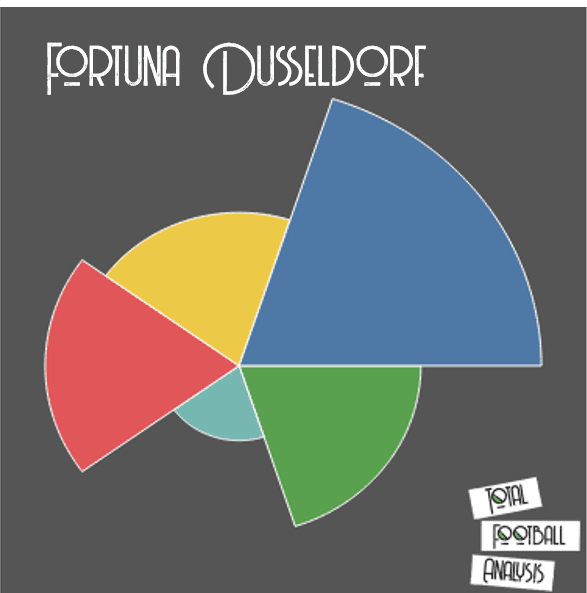
Düsseldorf are currently sat in 16th place, meaning should they stay there, they will be involved in a relegation play-off with the team that finishes third in the 2. Bundesliga.
They are on 22 points, and have the lowest expected points of any team in the league with 21.7, suggesting that on form they should be very worried about the run in to the end of the season.
They do have winnable games in and around a run of very difficult fixtures. They will have to play Schalke, Bayern Munich, Hoffenheim, Borussia Dortmund and Leipzig in a row, putting a huge emphasis on their other four games.
Uwe Rösler was brought in after Friedhelm Funkel was sacked, and the jury is still out on him. They have registered one win, one loss and three draws in the league since he’s taken over. Rösler has never managed in the Bundesliga, and with the bottom end of the table looking very tight it was a surprise to see Düsseldorf appoint a manager with no experience in this league, let alone in a Bundesliga relegation battle.
They predominantly played a 4-4-2 before Rösler took over, yet he has favoured a system based around a 3-5-2.
Düsseldorf aren’t a potent attacking side. Along with Werder Bremen they have scored the least amount goals this season with 27. However, where Bremen are underperforming their xG of 32.33, Düsseldorf are actually, incredibly, outperforming their xG of 24.58. This is the lowest xG of any team in Europe’s top five leagues. In short, they aren’t working good chances. Their xG per shot of 0.083 is incredibly low, yet their 11.23 shots per 90 minutes is only minimally lower than the league average.
Kevin Stöger is important to their build-up, dropping deep from his position as an attacking midfielder in Düsseldorf’s midfield three to support. Düsseldorf only manage 44.6% possession, and are direct in their approach as we can see from the graph. Similarly to Augsburg (one of many similarities), they play a lot of long passes, however, whereas Augsburg had the worst accuracy in the league, Düsseldorf have the fourth-highest completion percentage, with an impressive 59.4%.
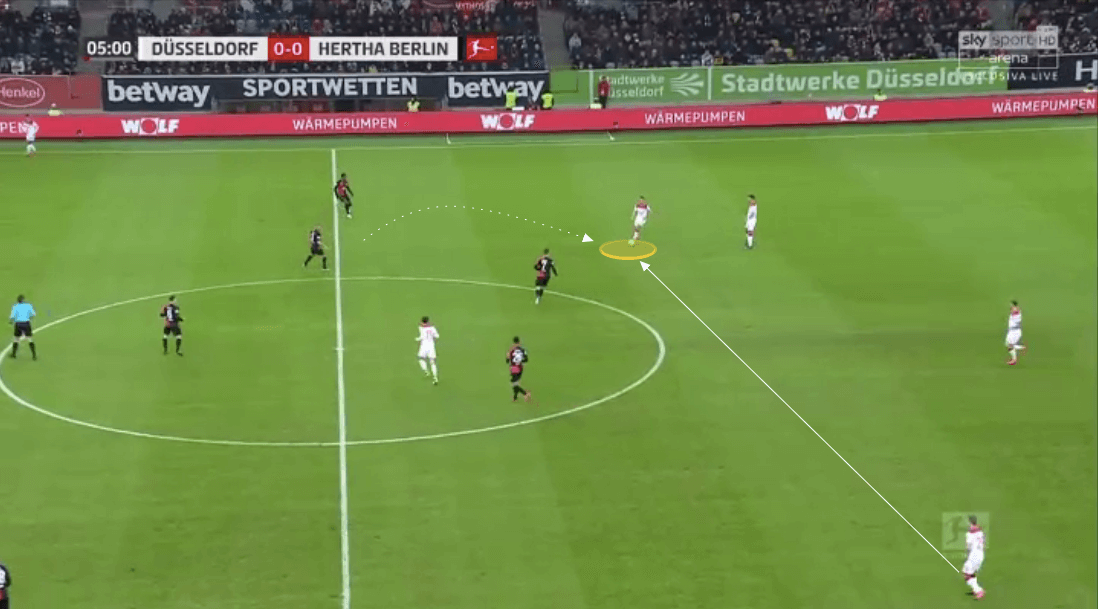
From these areas Stöger will launch longer balls to the wings or over the top for the forwards to run onto, which they are dangerous with should the opposition leave space behind. His 3.37 through passes attempted per 90 minutes is by far the most attempted by any player in the entire league. He is also available on a free transfer this summer.
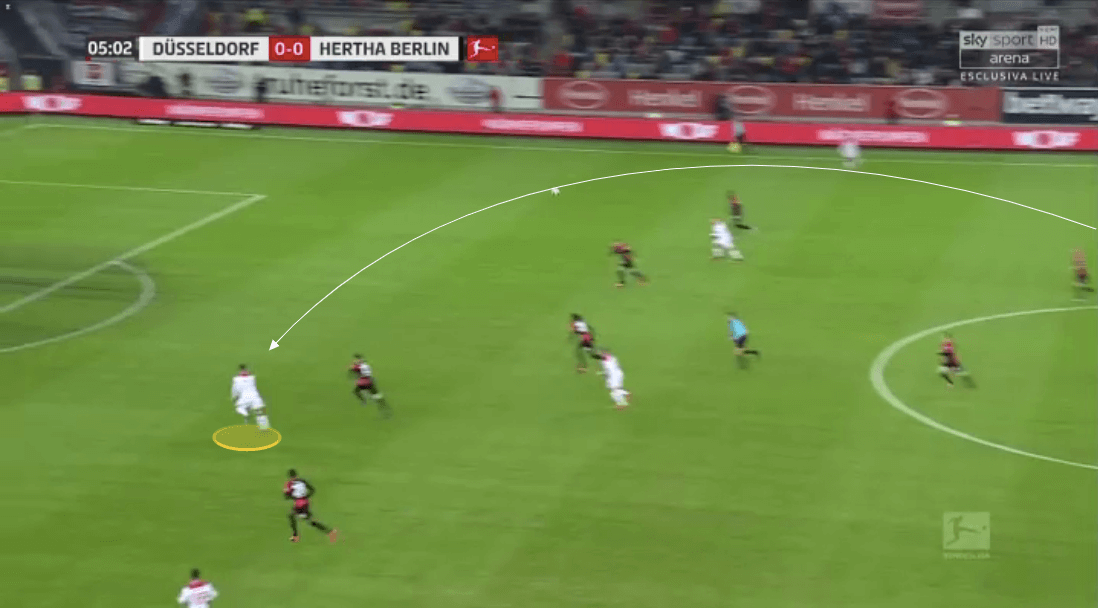
In more advanced attacks they leave two players out wide, and for a side who aren’t used to having a great deal of possession, they put a lot of crosses in.
If they can stretch the opposition enough to thread a ball through the middle then they will, but they will use the wingers to put in cross after cross should the opponent stay narrow defensively.
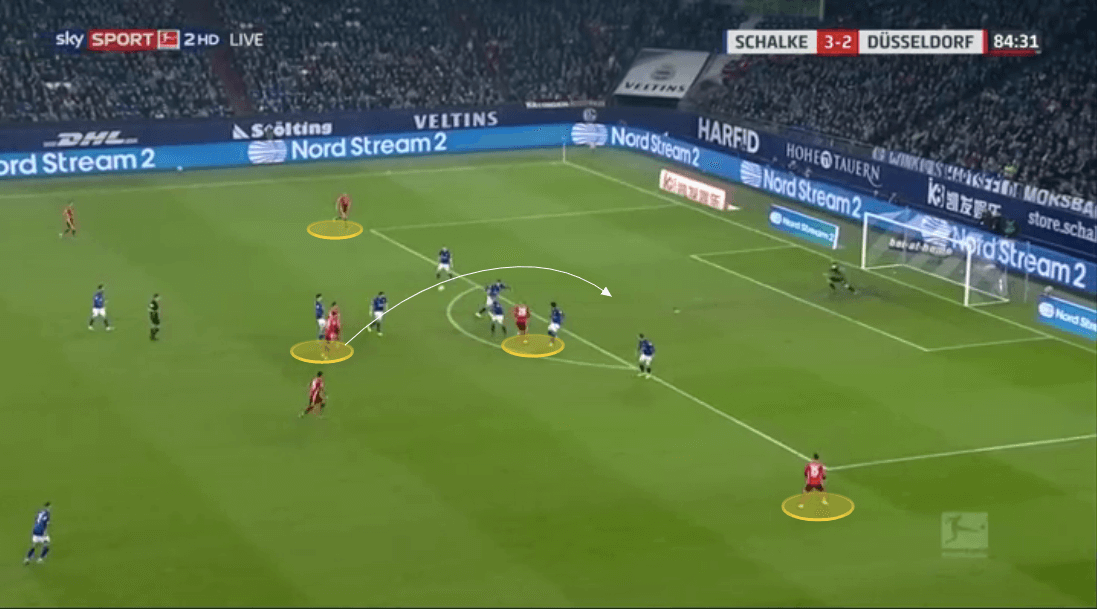
Their 13.8 PPDA shows they are less interested in winning the ball back in high areas, and would rather absorb pressure before looking to hit teams on the counter.
They do this effectively too. Erik Thommy is superb at covering ground quickly and closing the gap between himself and his forwards on the counter to create an overload.
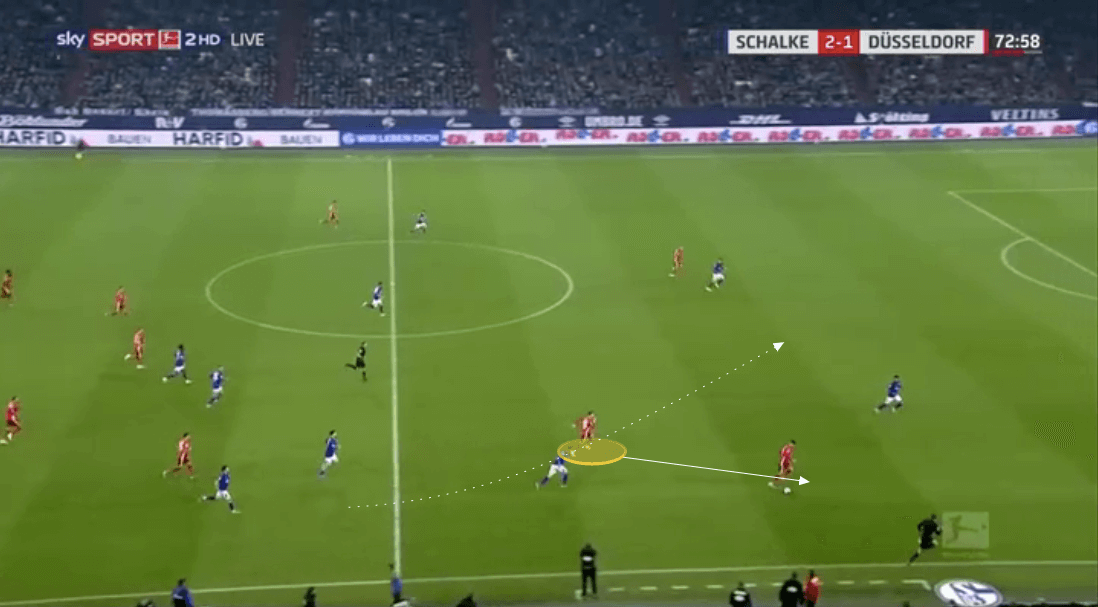
Manchester City loanee Zack Steffen has lost his place to Florian Kastenmeier in goal. Steffen was conceding 1.91 goals a game, exactly his expected conceded goals. Kastenmeier is conceding 1.55 goals per game, outperforming his xCG of 1.77, suggesting he is doing a slightly better job than Steffen was. However, Steffen was facing marginally more shots per game.
Key players: Hennings, Stöger, Erik Thommy
Expected points: 21.7
Actual Points: 22
Remaining fixtures: Paderborn (h), Köln (a), Schalke (h), Bayern Munich (a), Hoffenheim (h), Borussia Dortmund (h), Leipzig (a), Augbsurg (h), Union Berlin (a)
Freiburg – long passes to stretch the pitch horizontally and vertically, swift rotations in wide areas, vertical passing
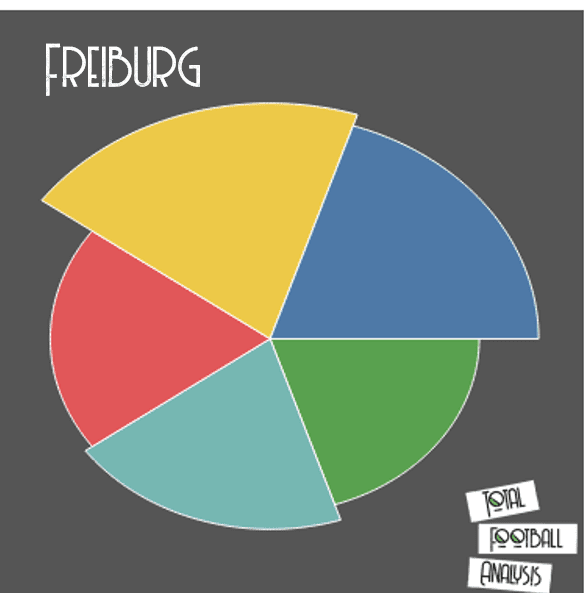
Freiburg continue to “overperform” on a modest budget and uncover rough diamonds to make significant contributions. They currently sit in eighth place, just one point away from Schalke, who sit in sixth and are in a Europa League qualification place.
Under veteran Head Coach Christian Streich they have mainly played a 3-4-3 or a 4-4-2 this season, and orchestrate their attacks from the back, with quick switches of play, penetrative line-breaking passes, or even just simple balls over the top.
They will use the centre-backs, Robin Koch in particular, to hit direct passes into the forward line for the centre-forwards to compete for or to run onto, but will also use long passes to stretch the play horizontally. Koch has an excellent passing range and is essentially used as a pivot in Freiburg’s back line. As they overload one side of the pitch, Koch will be used to quickly and accurately switch the play to the other flank. He takes on a quarter-back role at times, and if teams are vertically compact, will look for well-placed through balls, regardless of how difficult an angle might be, like in the image below.

There is an emphasis on smart wing-play too, particularly coming from their right-back Jonathan Schmid, and left-back Christian Günter who are both consistent performers. Both of these players will stay high and wide during build-up if the ball is on the opposite flank, and act as the outlet for Koch’s passes. They engage in swift and simple rotations with whichever winger is in front of them, and one of their centre-forwards will move across to the flank to create an overload at times too as we can see in the image below, creating space for Schmid to make a run into to receive behind the defence.

Both full-backs are good on the ball too. Schmid’s 35.71% cross completion, and Günter’s 38.89% cross completion, rank them both comfortably in the top 20 players in the league for this metric. The higher they play the closer their skilful attacking midfielders like Vincenzo Grifo, Rolland Sallai, and Kwon Chang-hoon to play inside closer to veteran forward Nils Petersen, should they be used on the wings.
Janik Haberer is another standout player. His manipulation of space in central-midfield is one of those things that’s very difficult to pick up on by looking at statistics. He will drift across midfield joining in with build-up play and particularly drop into the right-back position, allowing Schmid to play higher himself, therefore stretching the press and allowing the full-back to receive between the lines.
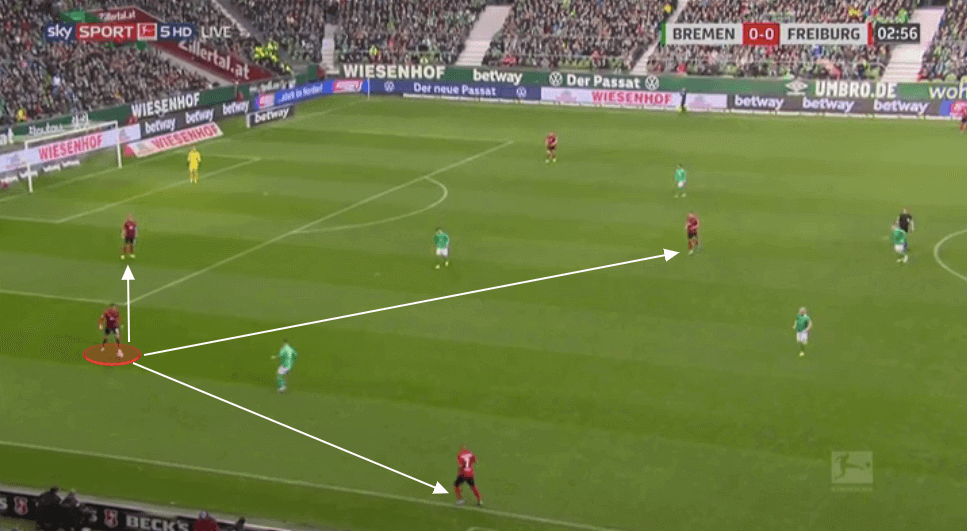
By dropping into these spaces he also creates potential central passing lanes or at the very least areas to drive into. He’s also available on a free transfer this summer.
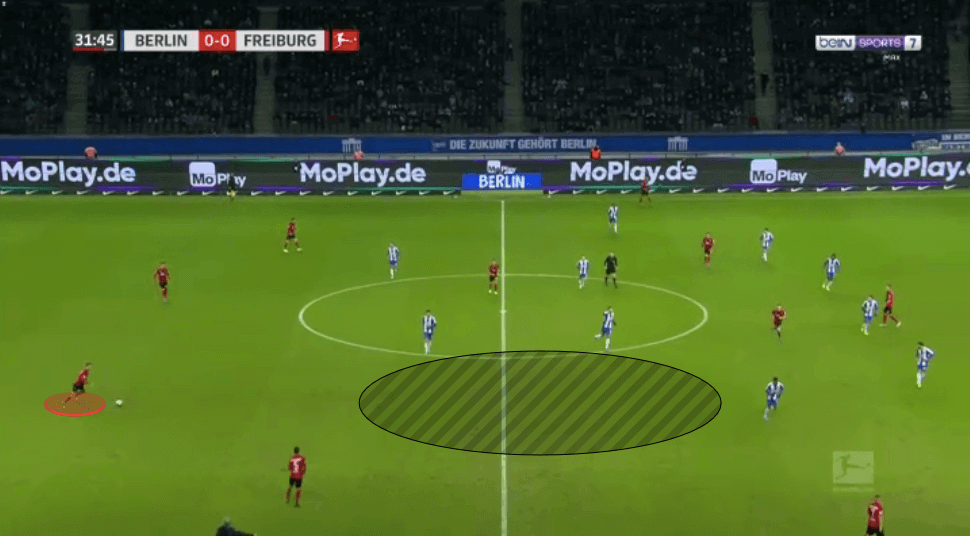
Teams will be swarming around some of their talent this summer with Robin Koch expected to leave for a Champions League team, however, the likes of Christian Günter, Philip Lienhart, Gian-Luca Waldschmidt and even Alexander Schwolow would be smart pick ups for certain top-half teams in the Bundesliga or Premier League.
Key players: Nils Petersen, Robin Koch, Christian Günter
Expected points: 29.6
Actual Points: 36
Remaining fixtures: Leipzig (a), Werder Bremen (h), Eintracht Frankfurt (a), Bayer Leverkusen (h), Borussia Mönchengladbach (h), Wolfsburg (a), Hertha Berlin (h), Bayern Munich (a), Schalke (h)
Hertha Berlin – A new approach under Bruno Labbadia? Or will they continue to sit back and try to catch teams on the break?
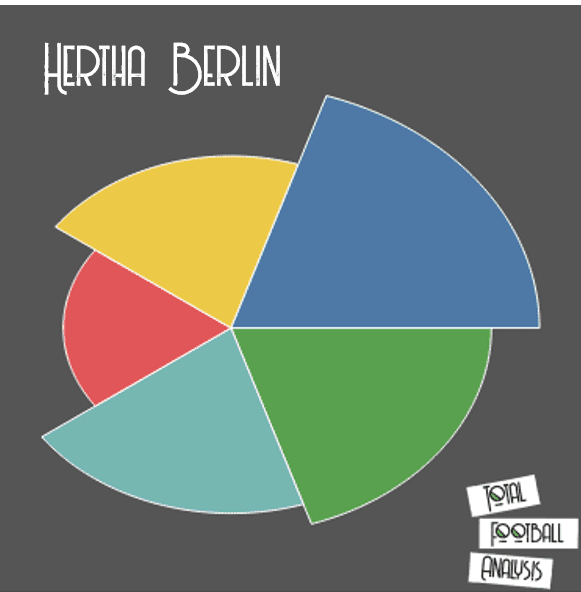
It’s difficult to know what we’re going to get from Hertha. This season has not gone to plan, and their owners don’t seem to have any concrete ideas in how to make Hertha into the big club that they think they are/should be other than chucking money around. In January they spent over 80 million euros, the most by any club in this transfer window, on Santiago Ascacibar, Matheus Cunha, Krzysztof Piątek, and Lucas Tousart (who won’t join until the end of the season.
If you look at their personnel there is no way they should be in trouble, but there doesn’t seem to be any direction or philosophy running through the club. New Head Coach Labbadia, appointed after the circus which surrounded Jurgen Klinsmann’s mid-season appointment, has a real job on his hands.
Initially, under Jurgen Klinsmann they started conceding far less goals, however, that’s unsurprising when they were operating in an incredibly deep block, and packing players behind the ball, which we can see by looking at the red part of the graph. Klinsmann obviously wanted to turn them into a dangerous counter-attacking outfit, and to be fair, with the likes of Dodi Lukebakio, Piątek, Cunha, and Javairô Dilrosun, that’s not a bad idea. They’ve managed eight points in the eight games they’ve played in the league in 2020, and although there were initial signs of at least better results under Klinsmann (although certainly not better football), things have gone from bad to worse after his bizarre departure. Since then they’ve conceded 11 goals in four games including a horrendous showing in the 5-0 loss at home to Köln. They have a difficult run-in to the end of the season and if they continue their free fall they may get sucked back into the relegation battle should the likes of Werder Bremen and Dusseldorf pick up some good results.
Defensively we saw them operate in a 5-3-2, shifting into a 4-4-2, with the central-midfielders focused on preventing any central passes from the opposition with wing-backs expected to push up to engage the opposition either side of them, as the rest of the back five slid across.
There have been some awful defensive performances, with them looking incredibly vulnerable on the counter, but frankly, their defensive organization in general has been found wanting at times too, particularly at the start of games. We can see their centre-backs too close to the one forward as they get punished on the counter-attack, leaving too much room in the left-back space. In their last three games, they have conceded five goals in the first ten minutes. This is surprising considering they have relatively good strength in depth at centre-back.

Labbadia favoured a 4-3-3 at Wolfsburg. He had a ball-playing side, and it will be interesting to see if he sticks to his guns, or adapts his approach to what Berlin have been doing already this season. He likes to play out from the back, and his centre-backs will get a lot of the ball, whilst allowing central space should the pivot want to drop in and receive. Hertha have shown they will at least seek to stretch the pitch and look to play out, so there are building blocks here where Labbadia could begin to impose his own philosophy. But of course, time is not on his side.

He favours a fluid attacking shape and will put a lot of players ahead of the ball, occupying the back line and pushing the opposition backwards, allowing plenty of space for his centre-backs and pivot to have the ball, and seek forward passes.
Labbadia also favoured an intense press at Wolfsburg, something Hertha have not looked to do this season.
He also played with a target man in Wout Weghorst and perhaps he may seek to use Vedad Ibisevic to the same effect. Berlin have plenty of height in general and are dangerous from set-pieces. Piątek hasn’t hit the ground running since his January move, scoring twice, with one a penalty, and Labbadia will need to find goals somewhere. With Cunha finding a little bit of form before the league was suspended, he may have a big role to play.
Key players: Marko Grujić, Maximilian Mittelstadt, Cunha
Expected points: 29.5
Actual Points: 28
Remaining fixtures: Hoffenheim (a), Union Berlin (h), Leipzig (a), Augsburg (h), Borussia Dortmund (a), Eintracht Frankfurt (h), Freiburg (a), Bayer Leverkusen (h), Borussia Mönchengladbach (a)
Hoffenheim – Building from the back, central build-up, and swift counter-attacking against the league’s best
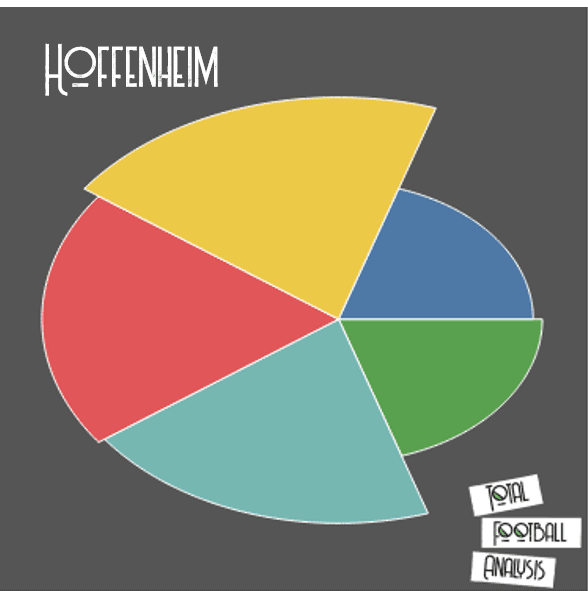
Another team in the hunt for sixth place is Hoffenheim who sit a point behind Freiburg and Wolfsburg, and therefore two points behind Schalke. Other than games against Leipzig and Borussia Dortmund they have a kind run of fixtures until the end of the season, and they may well fancy their chances of snatching that last European places. Which is interesting because this team has really been one in transition this year. Alfred Schreuder, favouring a back three more at the beginning of the season but recently using a 4-1-4-1 or a 4-2-3-1 more frequently, has played his players in all kinds of positions. Partly down to injuries, a lack of depth in the squad, and maybe just a little curiosity on his part, we have seen attacking winger Robert Skov get significant minutes at left-back, and central-midfielder Sebastian Rudy at right-back too, for example.
Nevertheless, after a slow start, we are seeing this Hoffenheim team make a late push up the table.
Tactically they look to build from the back with a single pivot dropping deep if they use a midfield four, or a double pivot if they use five in midfield, whilst their back four spread wide and deep to stretch the opposition press. They are pretty set in playing short from the keeper to the centre-backs and it can make for some interesting phases of play against teams using a high press like below.
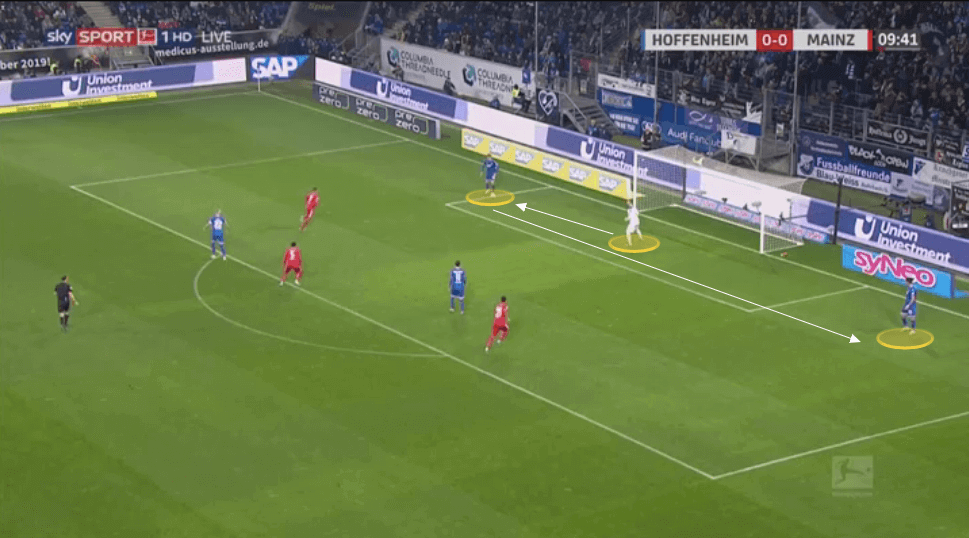
Schreuder favours central build-up. They play a lot of through passes in order to break lines. Centre-back Benjamin Hübner, and central-midfielder Florian Grillitsch have the first and third highest through pass completion percentages in the league with 53.57% and 50% respectively. Sandwiched between them is Phillipe Coutinho.
When they seek to play into the forward line, directly from defence, they will employ a midfield box, similarly to Dortmund, using a double pivot to create this space. They will most definitely seek to do this when they use a back three.
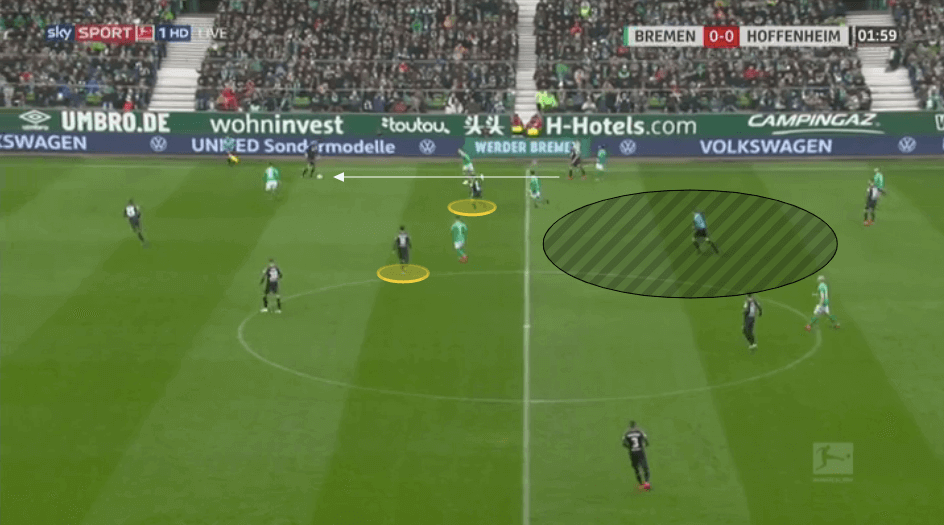
Compared to teams who value similar playing principles of building up and breaking lines with vertical passes, they have a lower PPDA. They still structure to prevent central play, but there isn’t any great intensity, certainly from the first line of press to win the ball back. Hoffenheim value blocking passing lanes and forcing the opposition into mistakes or making them play long. Once the ball is played long and regained, they will set about breaking down the opposition once again. This is less the case against teams who are potentially superior to them, and they will definitely fancy their chances against Leipzig and Dortmund later this season.
They’ve had a fair amount of success against the top five this season, with eight points in 11 games so far against these teams (other than a rather embarrassing 6-0 loss to Bayern). They drop players back into a low block, and look to catch them on the break, using a simple, up, back and through passing structure to break forward in stages ensuring players are always around the ball, as much to secure possession as to counter-press should they lose possession in these quick breaks.
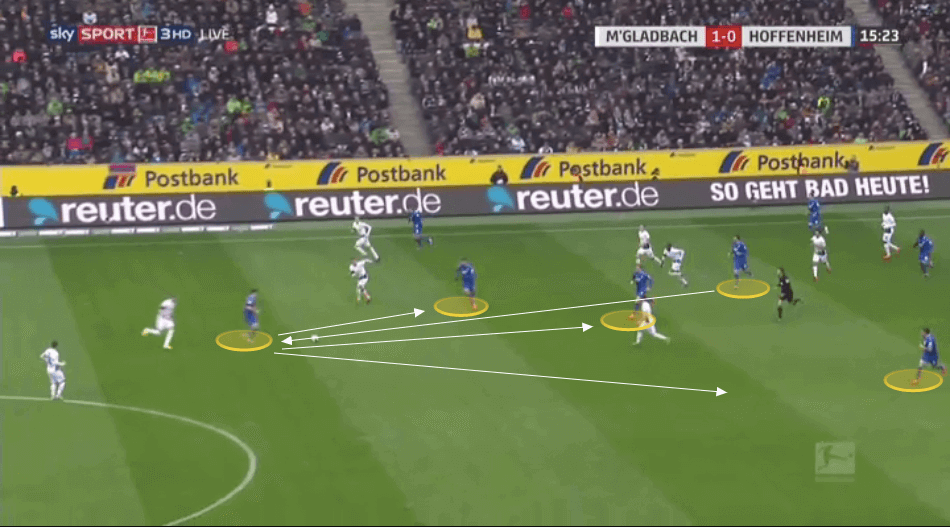
Key players: Florian Grillitsch, Andrej Kramarić, Benjamin Hübner
Expected points: 32.5
Actual Points: 35
Remaining fixtures: Hertha Berlin (h), Paderborn (a), Köln (h), Mainz (a), Fortuna Düsseldorf (a), Leipzig (h), Augbsurg (a), Union Berlin (h), Borussia Dortmund (a)
Köln – Direct passing, effective pressing, and dangerous counter-attacks
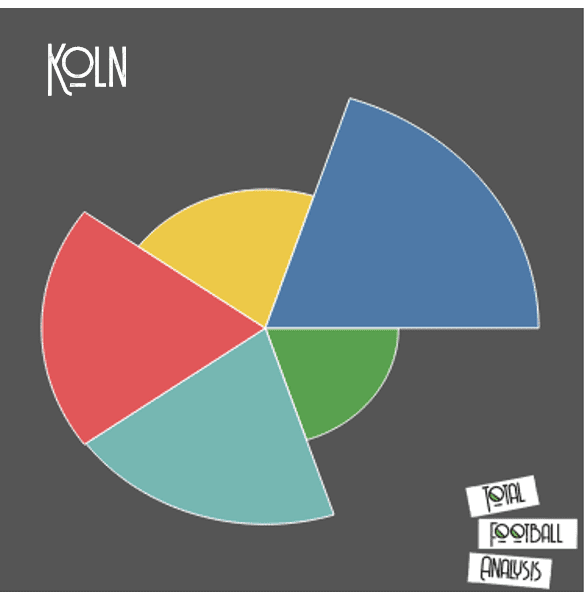
Köln had a slow start to the campaign, with Achim Beierlorzer’s commitment to long ball football not working. Markus Gisdol came in at christmas, and so far has a 57.14% win percentage. In Beierlorzer’s entire spell of 13 games in charge at Köln, he managed just two wins. Gisdol has eight wins in all competitions so far in his 14 games in charge. As managerial changes go, this has certainly been one of the better ones.
Gisdol hasn’t reinvented the wheel by any means. He also likes to be direct in possession. They play 51.13 long passes per 90 minutes, the third highest amount in the league, and have a 59.8% completion on these types of passes, again the third highest amount in the league.
The majority of their attacks come from getting the ball into the forward line quickly, whether that’s directly into their feet, having players run off a target man as they compete aerially, or balls over the top. Centre-forward Jhon Córdoba is big, strong and quick and a real handful.
Köln have a relatively intense press, as their 10.77 PPDA would testify, pressing with a front three where the central player sits deeper to protect the inside pass to the opposition pivot. In deeper areas, they will drop into a 4-5-1 or 4-1-4-1, where the wingers will be expected to push up to press full-backs, whilst the lone centre-forward works the opposition defence.
Córdoba is excellent in transition, holding the ball up and quickly releasing it to play players in before joining in himself, but just as good getting himself into space on these counters.
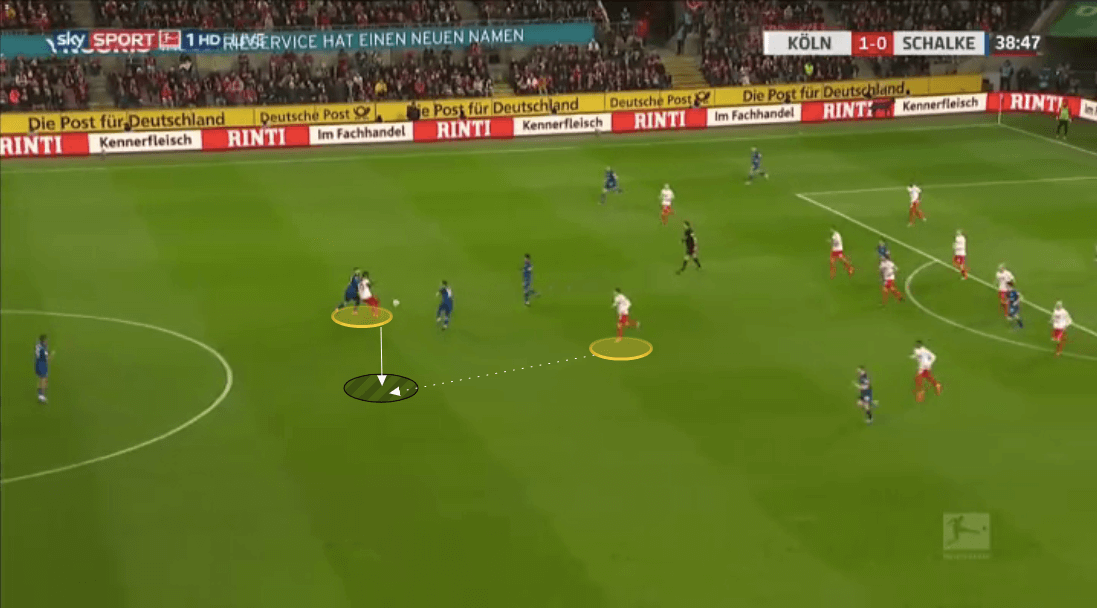
He isn’t exclusively a target man when it comes to counter-attacks. He has excellent pace and five of his ten league goals this season have come from counter-attacks, just like the one below where he’s able to burst forward in space and capitalise on the last man getting pulled towards the ball-carrier. It should also be noted he had only scored once this season before Gisdol took over, showing how quickly Gisdol has improved his game, but also showing how much Köln’s counter-attacking has improved under the new manager too.

In build-up play, they generally look to use the flanks, with the full-backs hitting direct passes into the front line, or creating numerical overloads on the wings before getting crosses in behind. Initially, Gisdol didn’t over commit going forward and his full-backs were relatively reserved. However, that approach has loosened a little. Young left-back Noah Katterbach is terrific on the ball in 1v1 situations and is worth keeping an eye on.
The full-back will overlap if the situation presents itself, however, will often look for a lot of diagonal crosses from deeper areas.
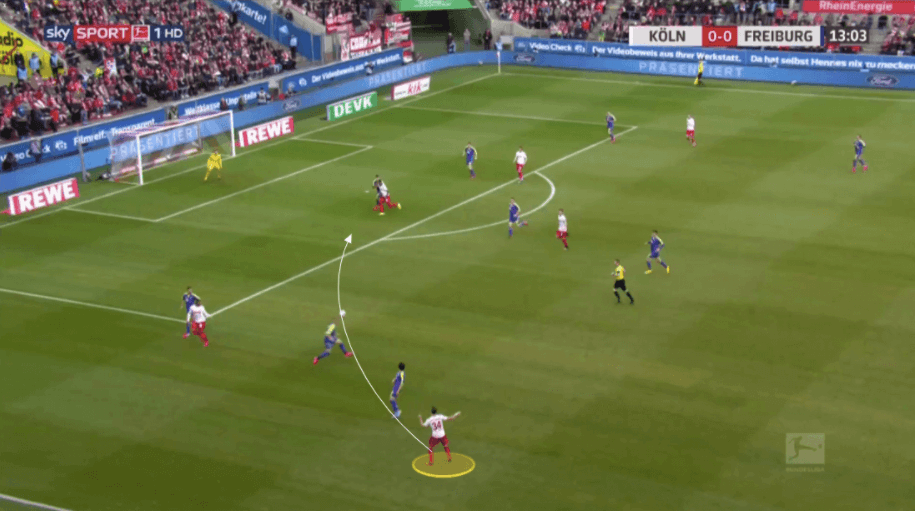
Key players: Jhon Córdoba, Jonas Hector, Sebastiaan Bornauw
Expected points: 33.9
Actual Points: 32
Remaining fixtures: Mainz (h), Fortuna Düsseldorf (h), Hoffenheim (a), Leipzig (h), Augsburg (a), Union Berlin (h), Bayer Leverkusen (a), Eintracht Frankfurt (h), Werder Bremen (a)
Mainz – Use a target man, plenty of width to create space inside, good counter-pressing
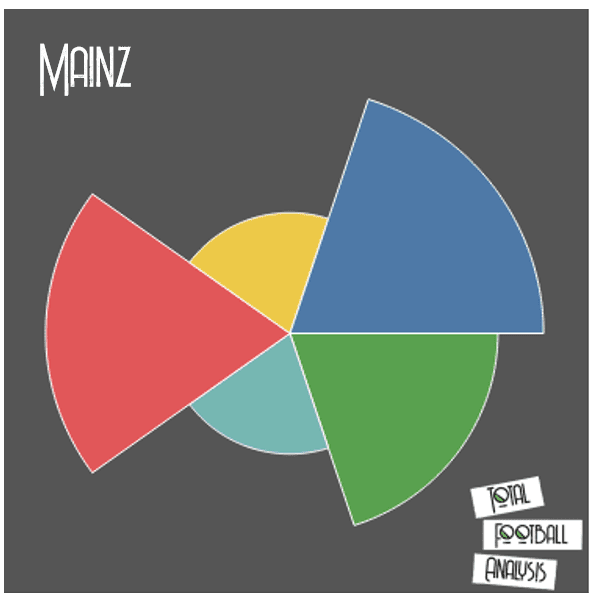
Beierlorzer struggled so much at Köln, and yet has done well at Mainz, where he took over immediately after leaving Köln. Under Beierlorzer Mainz have managed to get 16 points from 14 league games, and when he took over Mainz had just 10 points from 11 games. They now lie in 15th place on 26 points, and the penultimate game of the season against Werder Bremen could be huge.
Much of their success for the rest of the season will depend on the form of centre-forward Robin Quaison, who has 12 goals for the season, eight coming under Beierlorzer’s reign, including two hattricks. The forward possesses good pace, and can hurt teams when space is left behind. Like at Köln, Beierlorzer has no issue playing long balls, and if the opposition aren’t ready for this, Quaison will thrive, as we saw with his goal in Mainz’s 3-1 loss against Mönchengladbach.
He isn’t the sort of forward that will start off moves, but will move off the ball to make sure he is on the end of the final pass. He positions himself between the lines, and will move late. He’s quick and doesn’t need to play on the last man, and therefore risk getting caught offside.
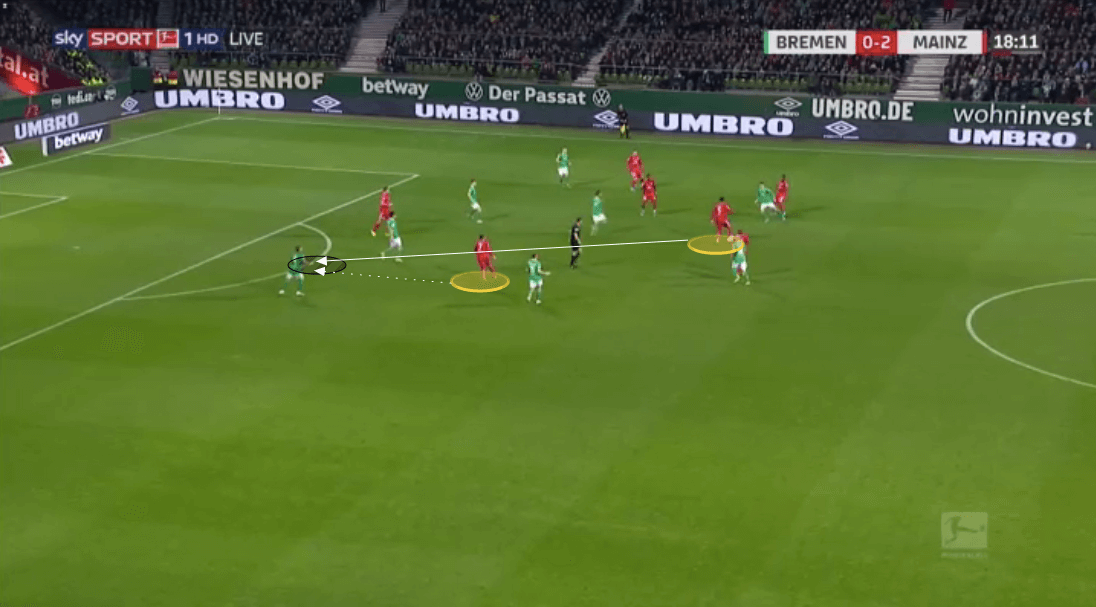
Quaison has been vital in filling the rather large sized hole left by Jean-Phillipe Mateta’s injury early in the season. He has since returned and naturally has taken a little time to get back to being close to the player he was last season where he scored 14 goals. He has two goals in his ten appearances so far this season, highlighting Quaison’s importance.
Mainz have generally used a 4-2-3-1 under Beierlorzer, but have also used a back three, and a 4-4-2 as well.
They look to get the ball forward quickly, using a target man to play off. They have no shortage of physical and able players for this role.
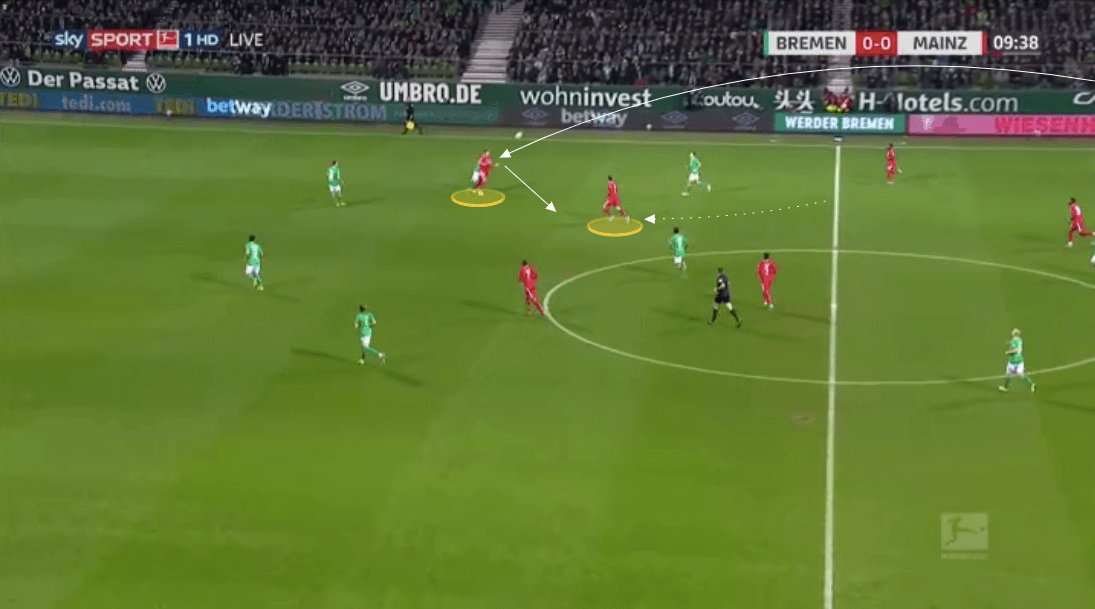
Mainz also keep their wingers very wide, and of course, these players are an outlet for them during build-up play, but importantly it creates plenty of space in the centre of the pitch.
They commit players forward to their press, and as the graph shows us, they are a very efficient pressing side, and consequently, should they win the ball back in midfield, they are able to counter quickly with plenty of forward options. When in possession they provide plenty of shorter passing options so they can counter-press quickly, and prevent the opposition from countering themselves.
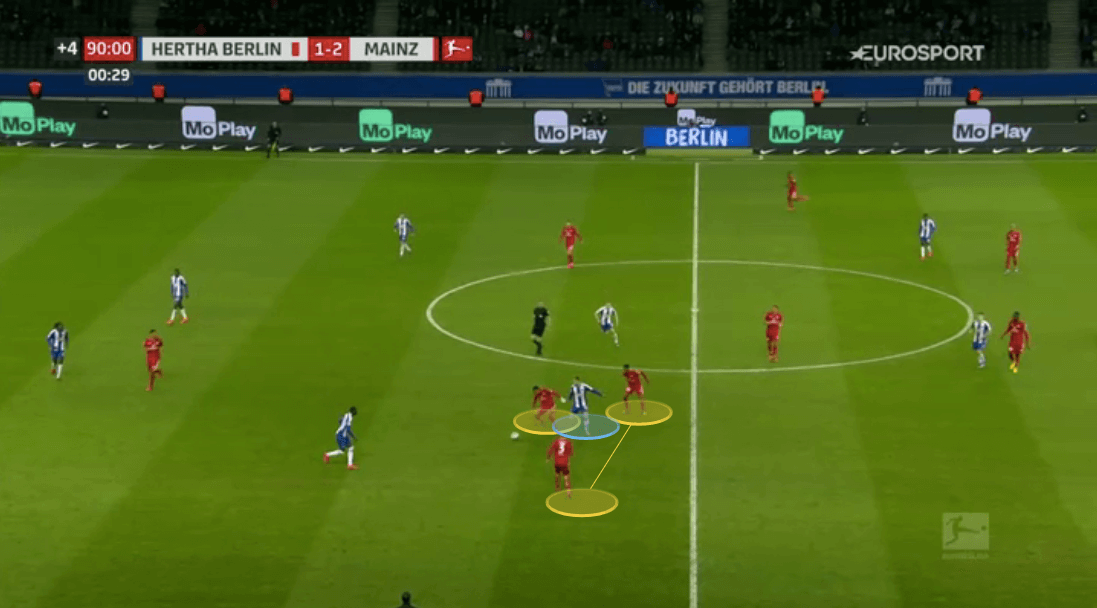
They can be more defensive and sat off against Borussia Mönchengladbach, and Bayern Munich, which is understandable, but continued the trend against Hertha Berlin and Schalke in the subsequent games, looking to use counter-attacks more than the approach mentioned above, however, seemed to revert in the three games that followed up until the league was suspended.
Key players: Robin Quaison, Boetius, Oztunali, Niakhate
Expected points: 27.2
Actual Points: 26
Remaining fixtures: Köln (a), Leipzig (h), Union Berlin (a), Hoffenheim (h), Eintracht Frankfurt (a), Augsburg (h), Borussia Dortmund (a), Werder Bremen (h), Bayer Leverkusen (a)
Conclusion
It is difficult to go into too much detail on these teams, and there is plenty missing in these brief analyses, however, hopefully, there is enough here for you to into the weekend’s fixtures with an idea on the how these six teams play, and you may well recognize some of the tactics highlighted in this analysis.
Tomorrow we will release part three, focusing on the final six teams.
You are going to love what Total Football Analysis are bringing you this weekend.
Starting with the Reiverderby in the German Bundesliga this coming Saturday, May 16 – Total Football Analysis will be bringing you live match commentary and analysis of Borussia Dortmund vs Schalke, kicking off at 14:30 UK.

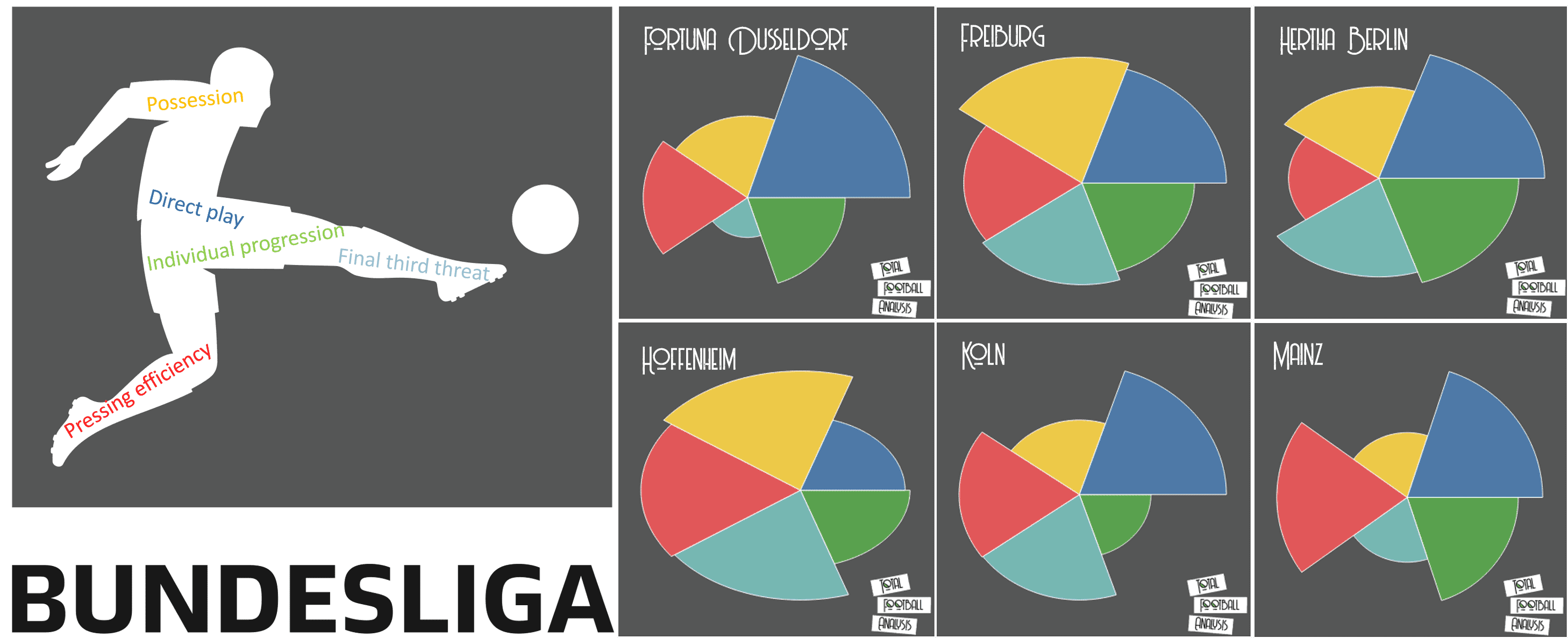
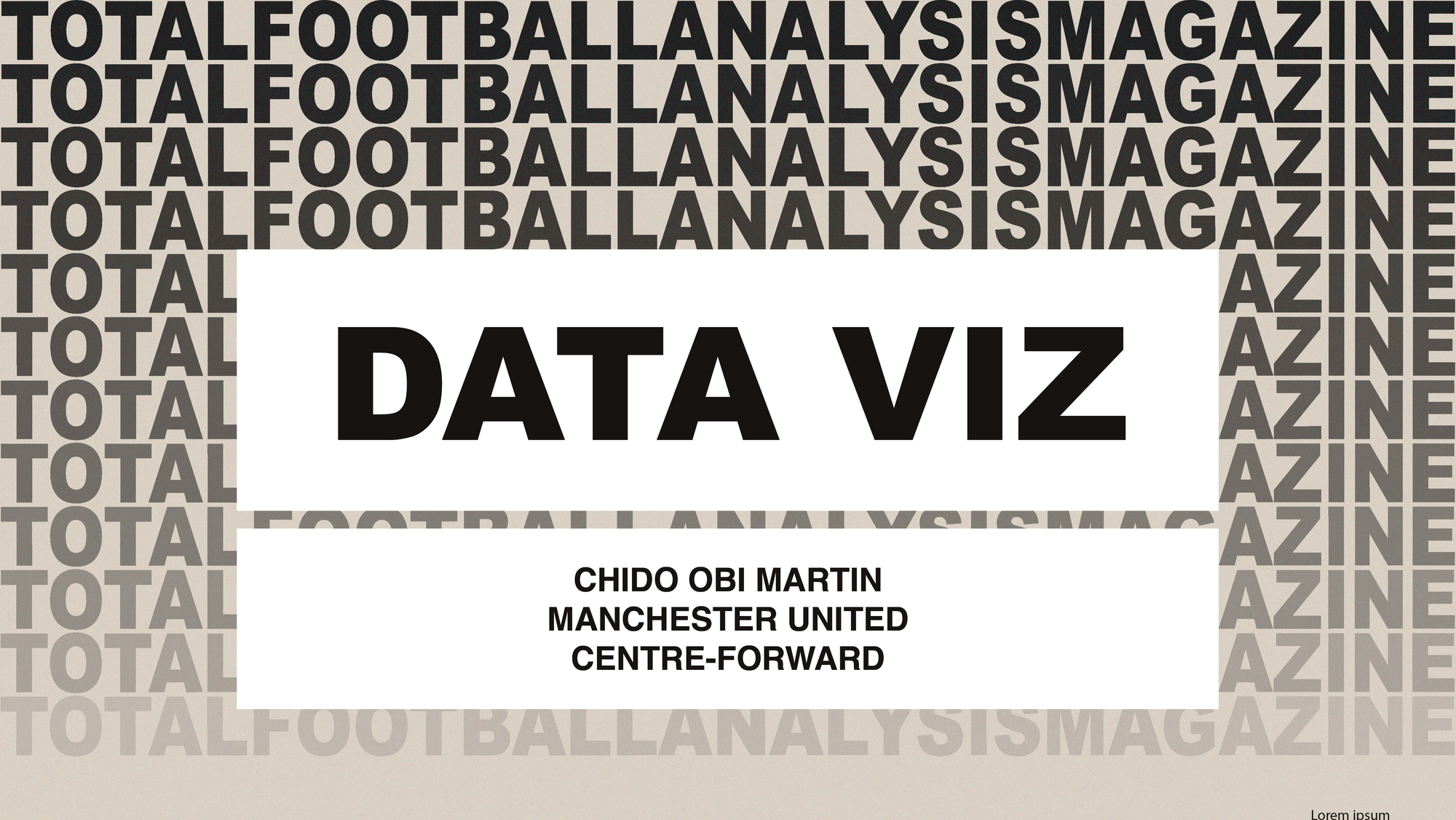
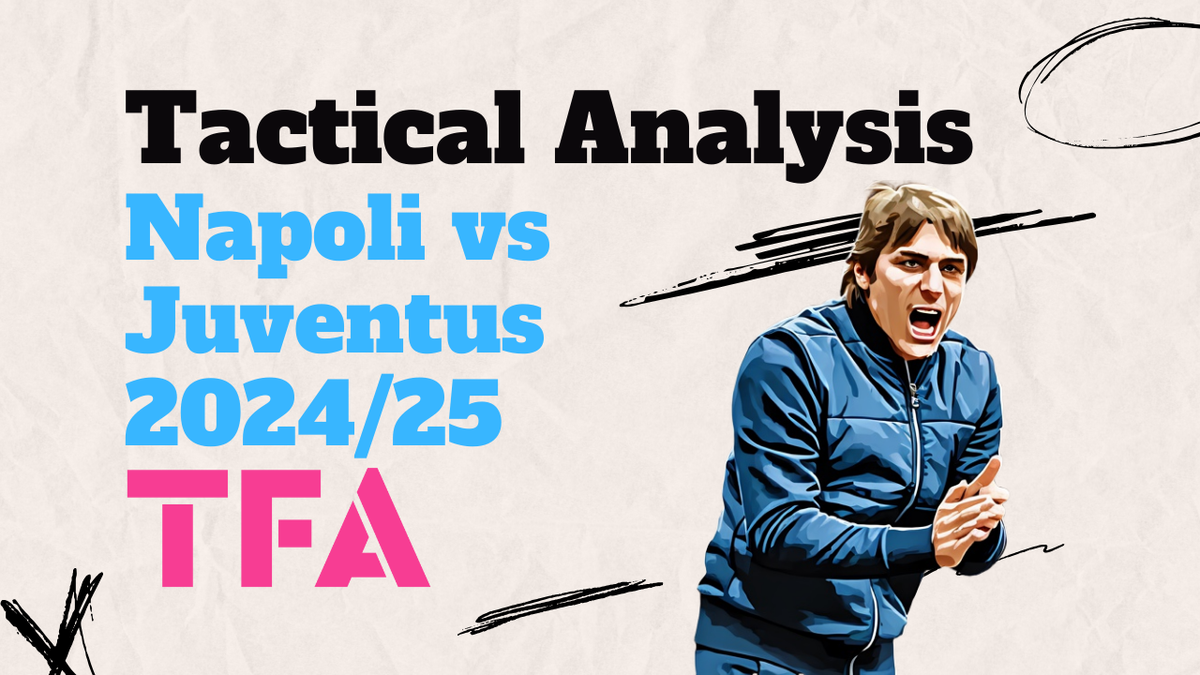
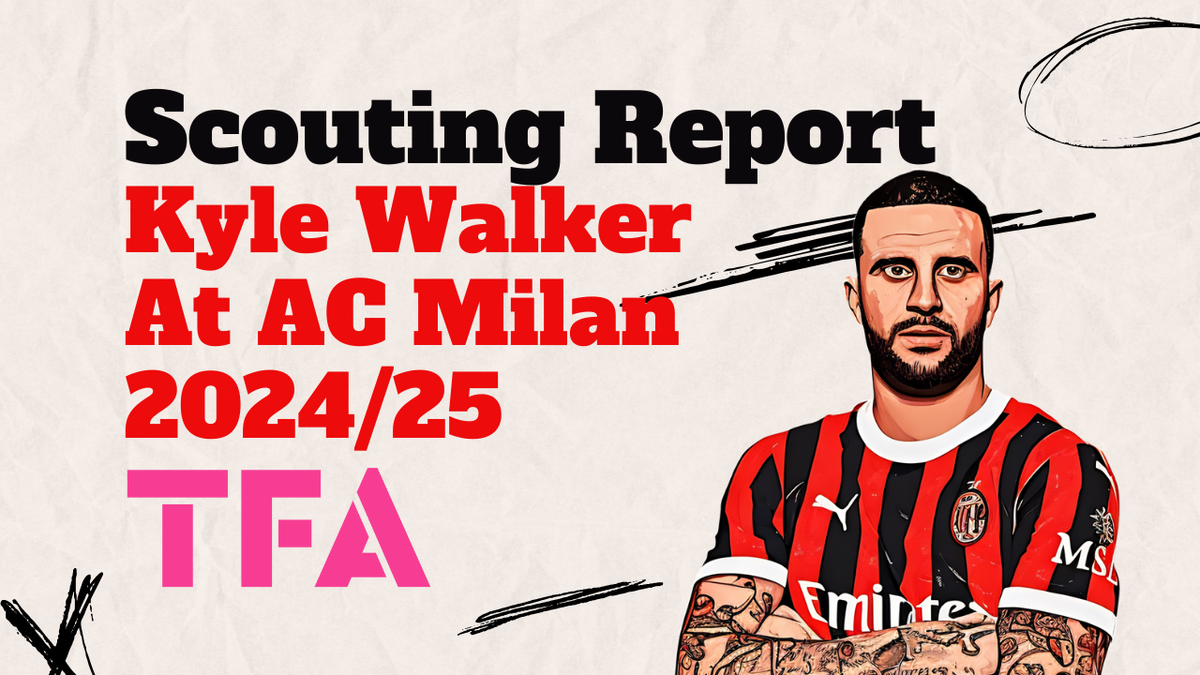
Comments